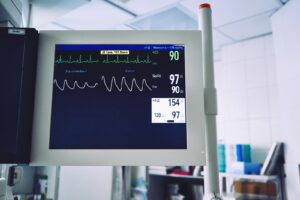bp monitor are important tools that can help you keep track of your blood pressure and treat high blood pressure. In this article, we will compare the top five blood pressure monitors for home use and recommend the best one for you.
What is a BP monitor and why do we need one?
When you are pregnant, your baby’s heart rate is always high because of the increased blood flow to the baby. A normal heart rate for a baby during sleep is between 120-160 beats per minute. As your baby grows, their heart rate will naturally slow down, but in some cases, it can be elevated due to a variety of reasons, including fever, stress, or illness.
If you notice your baby’s heart rate is consistently elevated above 160 beats per minute (or if it spikes suddenly), it’s important to contact your doctor. There are several different types of BP monitors on the market today, and each has its own benefits and drawbacks.
Here’s a look at the three most common BP monitors used in hospitals:
1) Monitors that use electrodes to measure blood pressure are known as “mechanical” monitors. These devices are generally more accurate than “electronic” monitors, but they can be more difficult to use and less comfortable for patients. They typically require two sets of electrodes (one on each arm) that are placed by a doctor or nurse. Some mechanical monitors also have a chest strap feature that lets you track your heart rate and breathing at the same time.
What are the different types of BP monitors?
There are many different types of BP monitors, but which is the best for home use?
There are a few things to consider when choosing a BP monitor for home use. The type of monitor you choose will depend on your needs and what you are looking for in a BP monitor. Here are some of the different types of BP monitors:
– ABP monitors: ABP monitors, or ambulatory blood pressure monitors, are the most common type of BP monitor. They are portable and can be used at home, work, or at any other location that has access to an electrical outlet. ABP monitors typically have a lower price point than other types of BP monitors and usually include features such as heart rate monitoring and interval recording. Some ABP monitors also include a phone app that allows users to track their data, share it with friends, and receive alerts if their blood pressure rises above certain levels.
– Indoor/outdoor monitors: Outdoor monitors measure blood pressure outside of the body, while indoor monitors measure blood pressure inside the body. Indoor monitors are generally more expensive than outdoor monitors but often include features such as heart rate monitoring and interval recording not found on outdoor models. Outdoor models
How to choose the best bp monitor for your home use
If you are looking for a home bp monitor, there are a few things to consider. The type of monitor you choose will depend on your needs and the devices you have in your home. Here are four of the best monitors for home use.
1. Philips Avent SCD630/10:
This monitor is great for parents who want to keep track of their baby’s heart health. It has a digital screen and an easy-to-use interface. The battery lasts for up to 10 hours, so you can easily take it with you if you need to move it from room to room.
2. Philips Avent SCD630/20:
The SCD630/20 is similar to the SCD630/10, but it has a higher-resolution screen that is good for monitoring multiple babies at once. It also features 20 sensors that can track heart rate, oxygen levels, and more. This monitor is great for families who want a comprehensive view of their baby’s health.
3. Philips Avent SCD630/30:
The SCD630/30 is perfect for high-traffic areas like homes with multiple
What are the pros and cons of each type of BP monitor?
The best BP monitors for home use typically fall into one of two categories: electronic and manual. Electronic monitors are typically more accurate but can be more difficult to use. Manual monitors often provide a better overall experience, but may not be as accurate.
Conclusion
There are a number of different types of home bp monitors on the market, each with its own advantages and disadvantages. Ultimately, it depends on your needs and which one is best for you. If you want to monitor your blood pressure at home regularly, then a hypertension monitor might be the right choice for you. However, if you only need to check your blood pressure once in a while or if you’re not worried about having high blood pressure levels, a wristwatch-based monitor may be more appropriate. Whichever type of home bp monitor you choose, make sure to read the instructions carefully so that you understand how to use it properly.

Leave a Reply